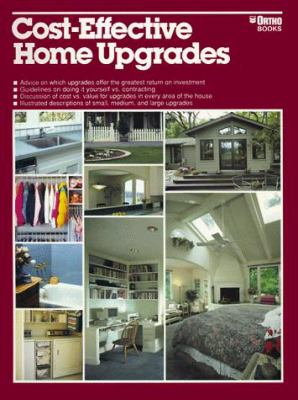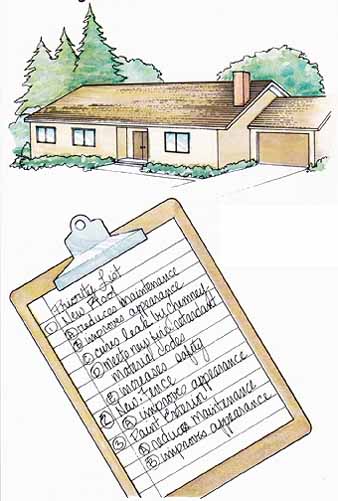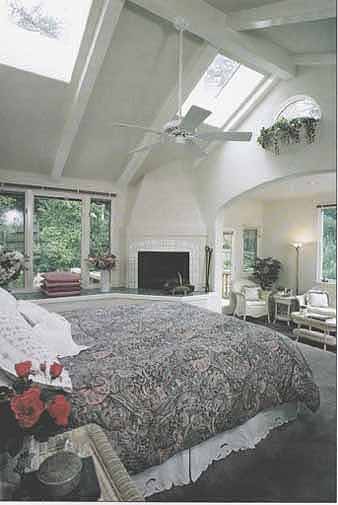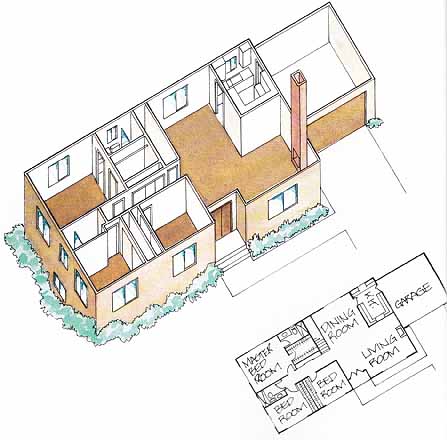Getting the most for your home-improvement dollar is a primary concern if you are planning to fix up your home, whether you are merely refinishing a bathroom light fixture or remodeling the entire kitchen. As a homeowner or a prospective home buyer you probably have several projects in mind. If you are like most people, you have neither the time nor the resources to accomplish all of them. This guide is designed to help you prioritize your wish list of home improvements by presenting information on the payback, safety, and convenience of dozens of typical upgrades. Where to begin, who to call, how to prepare, when to do it, and tips on how to do it—it’s all here. The emphasis is on moderately priced projects you can do yourself but major improvements that you will likely delegate to a professional are also included.

Content in this Guide adapted from book above (Copyright 1992, Ortho)
Adding slope to the flat roof of this home resulted in a spacious, airy living room with a dramatic vaulted ceiling, Pailadian window over the front door and gracefully descending stairway from the new second—story addition.
Where to Begin
Planning is the secret to home-improvement success. This section will help you set priorities to determine which project is the most important and most cost-effective, make a master plan to estimate costs and prevent construction conflicts, develop detailed plans, determine a budget, and decide how the work will be done and who will do it.
Getting an Overview
An upgrade can be as easy and uncomplicated as regular home maintenance. Buffing a porcelain bathtub can compensate for years of wear and lost luster. Such face-lifts can make your bathroom more pleasant to use as well as being cost-effective if you are selling your home.
Major improvements can also bring a high return on your home-improvement dollar. In addition, spending $50,000 to remodel a bathroom can be more cost-effective than moving when you consider that the combined costs involved in selling your house, buying another, and moving can equal 10 percent of the sales price of your house.
Monetary return is a significant consideration in every home-improvement project. This return includes resale value, prevention of costly re pairs, and reduced upkeep costs. For example, it's more expensive to install a ceramic- tile shower over a mortar-bed backing than it's to glue ceramic tile directly to wall board; however, mortar adds strength, smoothness, and superior waterproofing. The additional 50 percent spent on mortar makes the improvement last three to five times longer. Projects that are not built to last diminish the return on your initial investment and may be several times more costly to repair.
Details are also important. Painting a door and leaving the old knob, or replacing the bath room floor covering and reusing a worn-looking heat register can result in an unattractive, unfinished appearance.
Not every remodeling project will provide a big re turn on cash invested. The justification for some projects, especially the more luxurious ones, will largely be increased personal pleasure and comfort. However, even luxurious renovations can be done cost- effectively. With proper planning you can meet your needs with minimal confusion and maximum cost-efficiency.
Studying the Neighborhood
When planning, the first consideration is the context of the home. It’s important not to over-improve or under-improve for the neighborhood. Over- improving a home can price it out of the market at resale time. In fact, the most expensive house in a neighborhood is often difficult to sell. Whether you plan to sell your home or stay in it, however, you would be wise to keep an eye on local home values to help you prioritize home improvements.
Getting to know the value of the homes in a particular neighborhood involves a little detective work. One easy method is to scan the real estate ads in local newspapers or look for a list of real estate transactions and the selling prices. (Some papers carry them.) Another method is to hire a real estate appraiser, although this can be expensive. The best alternative is to contact a local real estate agent. Most will pro vide a detailed market analysis, usually at no charge.
In a healthy real estate market, it’s a good rule to avoid improvements that will raise the value of a home to more than 20 percent above typical values in a neighborhood. In a sluggish market it’s best not to push the remodeled value of the home above typical values at all. For homes in mixed- value neighborhoods, it’s smart to keep remodeled values no higher than the top values, no matter what the condition of the real estate market.
As the following examples show, the math is easy.
+ In a healthy market the owner of a $180,000 home in a neighborhood of $220,000 homes should set a cap on improvements at $84,000, for a remodeled value of $264,000 ($220,000 + 20 percent).
+ In a sluggish market the owner of a $180,000 home in the same neighborhood should spend no more than $40,000, for a remodeled value of $220,000.
+ In a mixed neighborhood where the top home value is $220,000, the owner of a $180,000 home should invest no more than $40,000, regardless of the market.
These guidelines mean that in many neighborhoods it's smart to resist the temptation to put in granite kitchen countertops, build a fifth bed room, or make other expensive improvements if they will in crease the value of the home beyond a reasonable level for the neighborhood.
On the other hand, not improving a home enough can also make it difficult to sell. If typical homes in a neighbor hood have two-and-a-half bath rooms, it’s a good idea for the owner of a one-bathroom home to add at least one more bath room to bring the home up to a level similar to the others in the neighborhood.
It is also important to try to match the quality of the other houses in the neighborhood. If your kitchen cabinets, counter- tops, and floor coverings do not match the quality found in other houses in the neighbor hood, the most cost-effective upgrade would be to make similar improvements.
Try to resist improvements that are very personal in nature. Even though you may want a bright pink polished-granite en try hall, dark brown wallpaper, or an indoor shooting range, many people probably will not, and they won’t be willing to pay for it. These types of individualized improvements, in many cases, lower the value of a home or even scare off potential buyers.

An older ranch—style home
with a shallow-sloped roof was given new life with contemporary doors and windows, a steeper roof added to the central portion of the house, and a master bedroom wing on the right side of the house, in which the
former enclosed BBQ was remodeled as the new bedroom fire place.
Setting Priorities
By setting priorities, you make sure that the most important and financially sensible jobs get done first. Although setting priorities may seem like an obvious first step, many home owners plunge headlong into projects, spending money and time on low-priority improvements when more important jobs are left undone.
For example, a family room addition is thought by many to be an attractive project that boosts home value. It can be potentially worthless, however, if the master bathroom of the home is outdated and its wiring is dangerously substandard. With a list of priorities, it’s easy to see that a new family room in this house is a “could,” a new master bath is a “should,” and rewiring is a must. Adding a family room to this house would be like putting new tires on a car with a bad engine.
Prioritizing Projects
When you are balancing a file folder filled with ideas against a limited home-improvement budget, some projects may end up at the bottom of the list or be dropped altogether. That’s the idea of setting priorities—to help ensure that the “musts” get done before the “shoulds” and that the “shoulds” get done before the “coulds.” The following is a list of priorities in order of importance.
1. Safety
Threats to family health and safety, violations of fire or building codes, and structural weaknesses should be given top priority. Do not undertake other improvements until these problems have been corrected. Safety-related improvements include replacing an old patio door made of nontempered glass, replacing dangerous electrical wiring (especially aluminum wiring), applying nonslip decals to the bottom of the bathtub, and reinforcing a bro ken or sagging structural member, such as a roof rafter or a floor joist. Also included in this category are security improvements, such as fire alarms, childproof cabinet latches, and exterior lighting.
=====
A Showcase of Cost-Effective Upgrades
The house illustrated here is showcased at the beginning of each section, where each of these upgrades and many more are shown and called out in detail. Later we will cover the front view listing all exterior upgrades. Later we will provide detailed illustrations and listings of upgrades in every room in the house. The most significant upgrades are listed here:
1. New siding
2. New window trim
3. New bay window
4. New front entry
5. New garage door
6. Arched pass-through to dining room
7. French doors to new deck off dining room
8. Built-in cabinets in dining room
9. Entertainment center in living room
10. New fireplace
11. Pop-out wall for breakfast nook
12. New garden window in bathroom
13. Whirlpool tub
14. Twin sinks
15. Open staircase to refinished attic
16. Built-in closets in bedroom
17. Entertainment center in bedroom
18. French doors to new deck with spa off bedroom
19. Window seat with bookshelves
20. Garage work space
=====
2. Cost Control
Any project that would help decrease utility bills, lower maintenance costs, or prevent a large repair in the future falls into the category of cost control. Such improvements include installing double- or triple-pane windows, adding insulation and weather strip ping, and repairing or replacing a leaky roof.
3. Basic Repairs
Often, seemingly minor improvements have as much impact as major upgrades on the overall appearance of a house and the family’s daily life. Most of the jobs in this category are simple fix-its or cleaning projects that take a little elbow grease, such as patching wall cracks, eradicating mildew, caulking a shower, removing countertop stains, cleaning and buffing a kitchen sink, caulking around window and door frames, refinishing a light fixture, and replacing a toilet seat. Other more expensive examples include replacing broken appliances, bolstering a sagging garage door, and re placing worn floors.
4. Appearance
The fourth priority consists of projects that improve the appearance, or curb appeal, of a home. Some people may argue that these improvements are fairly costly compared to the direct, functional benefits they provide. It is difficult to mea sure the impact of, say, new exterior shutters. But to consider them unnecessary be cause they have no actual function can be shortsighted. Like general repairs and maintenance, changes to the exterior or interior of a home for appearance’s sake can make a big difference, especially if the home will be for sale in a year or two. Improvements in this category include installing a new front door, painting the exterior, replacing floor coverings, adding crown molding or chair rail, replacing plastic tub surrounds with ceramic tile, adding a greenhouse window in the kitchen, and installing a skylight.
5. Function
Improvements that make the home function more efficiently and that have a direct impact on daily life make up the fifth category of priorities. A large variety of improvements fall into this category, and they cover a wide price range. A functional improvement in the kitchen could range from a new dishwasher to a complete redesign and remodeling. Functional improvements else where in the house would include an extra bathroom for the children, basement storage shelves, a larger garage, and extra clothes closets.
6. Life-Style
Life-style improvements tend to be expensive but are some of the most effective and fun to do. Examples include adding a family room, expanding the master bath to handle the morning needs of two working people, turning a spare bed room into a study, adding a deck, and installing a whirlpool bath or a home spa.
7. Luxury
Luxury improvements fall into the “want” category. They can be done cost-effectively, but they are usually so user specific that the return on investment can be very poor, especially if they result in an over-improvement for the neighborhood. But if the money is available, and if you have taken care of higher priority home improvements, you may be able to justify such luxury improvements as an indoor pool, a billiards room, a sauna, walnut wood work, or a kitchen full of commercial-grade appliances.
Combining Priorities
A single improvement, in many cases, can take care of more than one priority. In fact, that should be the goal. For example, a garden window can lend beauty to a room; if it's a double- or triple-pane window, it can also be more energy efficient than the window it re places. Another example is a repainted house exterior, which adds curb appeal and also protects the exterior surface. The illustration above shows how a new roof combines the most priorities of the three possible upgrades listed; hence, it's the most cost-effective.

Combining Priorities: The
most cost-effective improvement is the one that combines the most priorities—in
this case, a new root.
Making a Master Plan
Planning improvements to a home is like putting together a jigsaw puzzle; seeing the big picture helps you to know how the pieces fit together. A master plan provides a way to look at the big picture.
Seeing the Big Picture
The first consideration when making a master plan is how projects will fit into the overall home-improvement scheme.
The master plan does not have to be very detailed; this is not the time to select paint colors or choose between wood and vinyl windows. Instead, you decide in general what improvements will be done—their scope, their location, and their timing.
A master plan enables you to make smart improvements that won’t have to be torn out in the future. It will help you to develop a preliminary long- term home-improvement bud get, which helps in setting up a savings or borrowing plan.
A master plan can save a lot of headaches and money down the road. Suppose that your home-improvement wish list includes a ceramic-tile tub en closure (priority 4, appearance) and , a few years later, a complete remodeling of the bath room (priority 6, life-style). Without a master plan, it would be impossible to know how the tub enclosure will fit into the eventual renovation, or whether it will fit at all.
Because a master plan is general in nature, it won’t say, for example, whether the floors in the future remodeled bath room will be covered with sheet vinyl, carpet, or ceramic tile. But it will say that the new bathroom should include a whirlpool tub. That’s important to know, because the tub will require a special pump- access door and possibly more space than the old standard- sized bathtub around which the original tub enclosure was constructed.
As another example, let’s say that a deck and a new family room are on your wish list. Both projects are priority 6 (life style), but the deck—a relatively inexpensive improvement—is scheduled to be done right away, and the family room—an expensive improvement—is scheduled for three years in the future. With a master plan, you could design the deck to fit around the future family room so that the deck wouldn’t have to be changed extensively or completely rebuilt when the family room is added.

This new bedroom addition
was designed to bring the outdoors in and convey an airy brightness with
skylights a vaulted ceiling with ceiling fan, and a window seat overlooking
the garden.
Setting and Getting Value
The second consideration when making a master plan is the value of specific improvements.
Although most people re model to make their house more enjoyable and more functional rather than specifically to increase its value, few families stay in one house forever. Therefore, resale value should be kept in mind when planning home improvements, be cause at resale time the value of individual improvements becomes vitally important. The table below gives an alphabetical listing of popular home-improvement projects and their value at resale.
Ranking Remodeling Projects |
|
Remodeling Projects Ranked by Value |
Remodeling Projects Ranked by Popularity |
|
|
Even when nationwide statistics show that homeowners are receiving an excellent overall return on home-improvement investments, the resale value of specific improvements can vary greatly. Extravagant, unusual, and overly personal upgrades usually return only a fraction of their cost, whereas the up grades that home buyers like the most will return most, if not all, of their cost.
It’s important to balance your needs against the return you can expect on your investment dollar. Set up your own criteria, and be clear on what you want, keeping in mind that resale value is the value other people put on improvements. When planning improvements, try to think like a home buyer.
What do today’s home buyers want? Mostly, they want bright, modern kitchens and large, luxurious bathrooms. Several consumer organizations and magazines periodically publish lists ranking home improvements by payback value. The left column of the table on above is an example of a list taken from a magazine in 1990. The list in the right column—by a national homebuilders’ association— ranks the top nine remodeling projects by popularity. Keep in mind that these polls can serve as guidelines, but they should not be the sole basis for your decisions.
A home improvement doesn’t have to be expensive to catch a home buyer’s eye. Of the first five improvements listed in the right column, only one (remodeling a bathroom) could be considered a major improvement. And, as the table above shows, projects such as increasing the energy efficiency of a home (particularly an older one), adding closet space, or putting in a skylight make a big difference to buyers and , in the end, may bring back their entire cost.
Looking at Cost Versus Value
The third consideration when making a master plan is cost. The table above is an alphabetical listing of popular home- improvement projects, their cost, and their payback at re sale. Although these values were calculated in 2009, you can use them as a benchmark. Since costs vary widely from area to area, the price ranges shown here are based on national averages. The wide range is due to three variables: labor cost (which varies regionally), the size of the room, and the degree of detail executed in the upgrade. The return percent ages reflect the value of the improvement if the house was sold within one year after the improvement was completed. The percentages are affected by the following factors.
+ The value of the home relative to others in its neighbor hood. Do the improvements add value, or do they just bring the home up to par?
+ The condition of the real estate market. The value of home improvements rises and falls with the ups and downs of the market.
+ The years since completion of the upgrade. In some, but not all, cases, resale value de creases over time.
+ Style and taste. What was popular last year might not be as popular next year.
+ Regional differences. Some improvements are valuable be cause of climate, tradition, or local preferences.
Rating the Upgrade
All of the upgrades listed in this guide are divided into three groups: small, medium, and large. Small projects are those that can be completed in a day or two for less than $500. Medium projects can be completed in two to six days for $500 to $2,000. Large projects cost more than $2,000 even though some can be completed in a day or two. Included in this last category are major remodeling projects, which in many cases can cost more than the original price of the house.
Home-Improvement Costs and Paybacks
Home Improvement |
Average Cost |
Return Percentage |
|
|
|
Also see: How To Design & Build Decks & Patios (Ortho Books, 1979)

